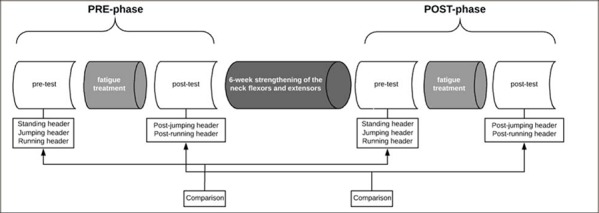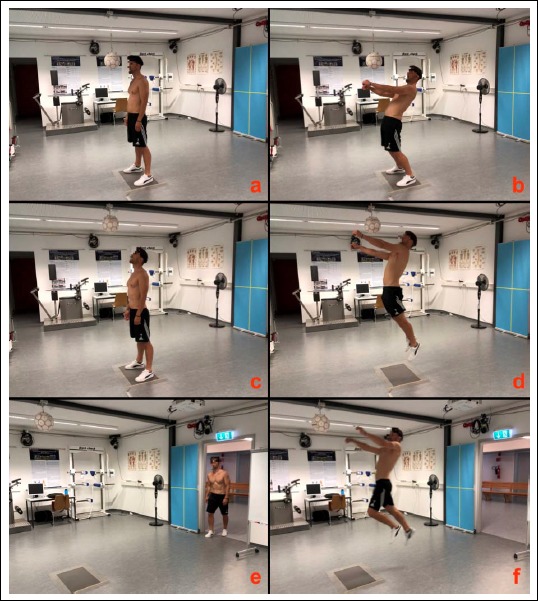Abstract
The importance of well trained and stable neck flexors and extensors as well as trunk muscles for intentional headers in soccer is increasingly discussed. The neck flexors and extensors should ensure a coupling of trunk and head at the time of ball contact to increase the physical mass hitting the ball and reduce head acceleration. The aim of the study was to analyze the influence of a 6-week strength training program (neck flexors, neck extensors) on the acceleration of the head during standing, jumping and running headers as well as after fatigue of the trunk muscles on a pendulum header. A total of 33 active male soccer players (20.3 ± 3.6 years, 1.81 ± 0.07 m, 75.5 ± 8.3 kg) participated and formed two training intervention groups (IG1: independent adult team, IG2: independent youth team) and one control group (CG: players from different teams). The training intervention consisted of three exercises for the neck flexors and extensors. The training effects were verified by means of the isometric maximum voluntary contraction (IMVC) measured by a telemetric Noraxon DTS force sensor. The head acceleration during ball contact was determined using a telemetric Noraxon DTS 3D accelerometer. There was no significant change of the IMVC over time between the groups (F=2.265, p=.121). Head acceleration was not reduced significantly for standing (IG1 0.4 ± 2.0, IG2 0.1 ± 1.4, CG -0.4 ± 1.2; F = 0.796, p = 0.460), jumping (IG1-0.7 ± 1.4, IG2-0.2 ± 0.9, CG 0.1 ± 1.2; F = 1.272, p = 0.295) and running (IG1-1.0 ± 1.9, IG2-0.2 ± 1.4, CG -0.1 ± 1.6; F = 1.050, p = 0.362) headers as well as after fatigue of the trunk musculature for post-jumping (IG1-0.2 ± 2.1, IG2-0.6 ± 1.4; CG -0.6 ± 1.3; F = 0.184, p = 0.833) and post-running (IG1-0.3 ± 1.6, IG2-0.7 ± 1.2, CG 0.0 ± 1.4; F = 0.695, p = 0.507) headers over time between IG1, IG2 and CG. A 6-week strength training of the neck flexors and neck extensors could not show the presumed preventive benefit. Both the effects of a training intervention and the consequences of an effective intervention for the acceleration of the head while heading seem to be more complex than previously assumed and presumably only come into effect in case of strong impacts.
Key points.
Presumed preventive benefit of a 6-week strength training of neck flexors and extensors could not be shown.
Changes in force of the neck flexors and extensors do not necessarily predict a change in head acceleration.
Pre-post-comparison before and after fatigue of the trunk muscles did not show any statistically noticeable changes in the acceleration of the head.
Further investigations with accelerated balls must follow.
Key words: Heading, kinetics, head-neck-torso-alignment, neck musculature, repetitive head impacts, concussion
Introduction
In recent years, heading in soccer has increasingly moved into the focus of the media and science. Lately, since the US soccer association banned heading in youth soccer (Yang and Baugh, 2016), a worldwide wave of interest and confusion has emerged due to the inconsistent state of evidence (O'Kane, 2016) on the evaluation of heading the ball. A further reason is the worldwide statistical increase in sport-associated concussions (Broglio et al., 2015; Cusimano et al., 2013). The cause for this trend can be seen in a generally more dynamic game on the one hand (Sarmento et al., 2018) and in an increased sensitization to the topic and the associated screening procedures on the other hand (McCrory et al., 2017; Sarmento et al., 2018). Besides, there are two mechanisms when considering the risks. Either the triggering of a concussion by an unintentional collision with another player, goalpost or the ground (Beaudouin et al., 2017) or the potential overload mechanism by thousands of repetitive head impacts during a soccer player’s career (Lipton et al., 2013). This leads to so-called subconcussive head impacts, which are not accompanied by the typical symptoms of a concussion (Tarnutzer et al., 2017) but are regarded as an increased risk factor in the long run (Lipton et al., 2013).
The importance of well trained and stable neck flexors and extensors as well as trunk muscles is increasingly discussed (Bretzin et al., 2017; Dezman et al., 2013; Tierney et al., 2008). In the case of unintentional headers, no major preventive effects are assumed, since the maximum head acceleration occurs within the first 30 ms (Naunheim et al., 2003; Queen et al., 2003), but the musculature needs approximately 200-250 ms to react adequately (Luo and Goldsmith, 1991). The greatest benefit is expected for intentional headers (Caccese et al., 2017; Dezman et al., 2013; Gutierrez et al., 2014), even if the absolute accelerations are higher with unintentional headers, but their appearance with approximately 4% they occur less frequently (Hanlon and Bir, 2012; Press and Rowson, 2017; Stewart et al., 2018). In the preparation phase, the trunk muscles are responsible for accelerating the trunk and head, starting an arched body tension, with the aim of achieving a maximum or adequate acceleration of the soccer ball (Caccese and Kaminski, 2016; Sunami and Maruyama, 2008). The neck flexors and extensors should in particular ensure a coupling of trunk and head at the time of ball contact, so that the physical mass hitting the ball is increased and the head acceleration is reduced (Caccese and Kaminski, 2016). According to this, stronger neck flexors and extensors would hypothetically provide a better connection of the anatomical structures and possibly make heading the ball in soccer safer.
The effect of a fatigued trunk on heading, which in this context also simulates weak trunk muscles, has rarely been investigated and the consequences are currently unclear. For this reason, the research on the influence of fatigue should be continued (Becker et al., 2017; Becker et al., 2018). If one follows the model that the trunk muscles must provide the necessary acceleration and secure the player from the oncoming impact by co-activating the neck flexors and extensors at the time of ball contact for a head-neck-torso-alignment (Bauer et al., 2001; Shewchenko et al., 2005b), then two compensation mechanisms for fatigued trunk muscles would be conceivable. In the first scenario the maximum ball speed can no longer be achieved due to the fatigued trunk muscles. In the second scenario the neck flexors and extensors compensate the fatigued trunk, resulting in a less arched body tension of the trunk by an increased nodding motion (Becker et al., 2013). As a result this would lead to a decoupling of the head-neck-torso-alignment, thus resulting in a reduced physical mass and therefore in an increased acceleration of the head, if the ball speed is kept almost constant (Caccese and Kaminski, 2016; Teymouri et al., 2012).
Currently there are two existing studies on the effect of a strengthening of the neck flexors and extensors. Mansell et al. (2005) compared the effects of an 8-week cervical resistance-training program on 36 participants in a pre-post-comparison with control group during headers in soccer. They were not able to show any kinematic, electromyographic or stiffness training effects. Lisman et al. (2012) evaluated the effect of an 8-week cervical resistance training on 16 players during American football tackles with no statistically augmented dynamic stabilization.
The aim of the study was to analyze the effect of a 6-week strength training for the neck flexors and extensors on the acceleration of the head during standing, jumping and running headers in soccer on a stationary pendulum header. In addition it should be examined, if the strengthening program affects the acceleration of the head after fatigue of the trunk muscles (post-jumping, post-running header). For a good comparison it is important that headers with the same or similar ball speed are paired, since the ball speed significantly influences the acceleration of the head (Babbs, 2001). In this context a larger number of results about the effects of the training intervention should help to evaluate training methods and contents as well as to clarify the presumed benefit for heading.
Methods
Participants
The sample included 33 active male soccer players (20.3 ± 3.6 years, 1.815 ± 0.07 c, 75.5 ± 8.3 kg). It consisted of two training intervention groups (IG1, IG2) and one control group (CG) (Table 1). In order to find out if there is an age-dependent difference in training effects, a youth team (IG2) and an adult team (IG1) were included for the training intervention. IG1 and IG2 were two independent club teams, whereas CG were sports students belonging to different independent club teams. The data acquisition started for all participants of IG1, IG2 and CG at the beginning of the season preparation. There were no dropouts in CG, dropouts were recorded for IG1 (n = 3) and IG2 (n = 8). They either did not meet the minimum number of twelve training sessions or suffered an injury during match/training which kept them from participating.
Table 1.
Characteristics and composition of the sample size without dropouts. Values are reported as mean ± standard deviation.
| IG1 | IG2 | CG |
|---|---|---|
| n = 11 6th German division age 22.7 ± 3.7 years height 181.1 ± 5.2 cm weight 76.9 ± 7.5 kg age of club entry (soccer) 4.8 ± 0.9 years soccer time per week 4-7 h/week |
n = 9 3th German youth division age 17.1 ± 0.9 years height 179.7 ± 7.6 cm weight 74.4 ± 11.7 kg age of club entry (soccer) 4.6 ± 0.8 years soccer time per week 4-7 h/week |
n = 13 6th, 7th German division age 21.5 ± 1.4 years height 182.5 ± 6.9 cm weight 77.5 ± 6.1 kg age of club entry (soccer) 4.5 ± 1.5 years soccer time per week 4-7 h/week |
IG1 intervention group 1; IG2 intervention group 2; CG control group.
The sample size was calculated using G*Power (Version 3.1 for Macintosh, University of Kiel, Germany). For a repeated (2x3) ANOVA (within and between interactions, f = 0.4, α = 0.05) a minimum group size of 30 persons was intended (power 0.968), which we increased due to expected dropouts.
All players had many years of playing and heading experience. There were the following exclusion criteria: chronic cervical spine problems, concussion within the last eight weeks, acute injury, acute infection or illness. All participants were informed about the test design, test procedure and potential risks before the start of the investigation and gave their written consent. In the case of minors, the parents or legal guardians were also informed and gave their written consent. The study was designed and conducted on the basis of the current guidelines of the Declaration of Helsinki (World Medical Association, 2013) and approved by the responsible ethics commission.
The experimental setup (Figure 1) consists of a PRE-Phase, which represents all measurements before the strengthening of the neck flexors and extensors, including a pre-test and a post-test. The PRE-Phase ist followed by the 6-week strength training of the neck flexors and extensors. Afterwards the POST-Phase starts, including a pre-test und a post-test again. The pre-test always consists of three different heading scenarios (standing, jumping, running), whereas the post-test asks for two heading scenarios (post-jumping, post-running) (see header). The difference between the pre-test und post-test is the fatigue treatment (see treatment) in between. To analyze the effectiveness of the 6-week strength training the two pre-tests (standing jumping and running header) and the two post-tests (post-jumping, post-running) are compared.
Figure 1.

PRE- and POST-phase mark the phases before and after the strengthening of the neck flexors and extensors. The object of this study is the comparison of the two pre-tests (standing, jumping and running header) and of the two post-tests (post-jumping and post-running header).
Acceleration
The head acceleration during ball contact was determined using a telemetric DTS 3D accelerometer (Noraxon, Scottdale, USA; size: 22x16x7 mm; weight: 2.8 g; frequency: 1500 Hz, filter: Lowpass 500 Hz) fixed in the occipital area of the head. An individually adjustable rubber band (Noraxon, Scottdale, USA; size: 1000x35 mm) was used for attachment and wrapped at least two times over the accelerometer and head to prevent motion artifacts in the best possible way. The resulting head acceleration vector a, based on the acceleration values of the x, y and z axis, was calculated by  . The values of the x, y and z axis were displayed through Qualisys Track Manager (Version 2.15, Göteborg, Sweden) with a sample rate of 1500 Hz. The point of the highest acceleration within six frames (= 0.03 s) was determined according to Naunheim et al. (2003), who summarized the first 0.015 s after ball contact to be the critical ones with regard to the head acceleration (Naunheim et al., 2003). For this purpose the accelerations within the first six frames were analyzed for each trial and the maximum value was picked. A recent study (Becker et al., 2018) supports the thesis that the point of highest head acceleration does not necessarily occur within the first frames of ball contact. For the comparison of the PRE- and POST-phase the ball speeds were evaluated. The pairing of the headers from the PRE- and POST-phase should have the same or similar ball speeds. This way we were able to compare the change of the head acceleration after a 6-week strengthening of the neck flexors and extensors with two headers having the same ball speed.
. The values of the x, y and z axis were displayed through Qualisys Track Manager (Version 2.15, Göteborg, Sweden) with a sample rate of 1500 Hz. The point of the highest acceleration within six frames (= 0.03 s) was determined according to Naunheim et al. (2003), who summarized the first 0.015 s after ball contact to be the critical ones with regard to the head acceleration (Naunheim et al., 2003). For this purpose the accelerations within the first six frames were analyzed for each trial and the maximum value was picked. A recent study (Becker et al., 2018) supports the thesis that the point of highest head acceleration does not necessarily occur within the first frames of ball contact. For the comparison of the PRE- and POST-phase the ball speeds were evaluated. The pairing of the headers from the PRE- and POST-phase should have the same or similar ball speeds. This way we were able to compare the change of the head acceleration after a 6-week strengthening of the neck flexors and extensors with two headers having the same ball speed.
Isometric maximal voluntary contraction (IMVC)
In order to make the effects of the training intervention measurable, an analysis of the isometric maximum voluntary contraction (IMVC) was recorded at the beginning of each pre-test by a telemetric Noraxon DTS force sensor (Noraxon, Scottdale, USA Inc; frequency: 1500 Hz; filter: lowpass 500 Hz). The participants were fixed in a lying position at chest and pelvic level to ensure an isolated movement from the cervical spine. An individually adapated sling was fixed to the head for both flexion and extension. For PRE-phase und POST-phase the standardized adjustment was made.
Header
Five heading variants (standardized order: standing, jumping, running, post-jumping, post-running) were performed, on a stationary pendulum header (Derbystar, model: Swing, size: 5, diameter: 22 cm) (Figure 2, Table 2). The ball had to be headed horizontally to the front as hard as possible. For the post-jumping and post-running headers the players first completed a fatigue program for the trunk muscles. The other conditions remained unchanged. In order to get used to the pendulum header and to minimize learning effects, the players executed three exercise attempts per variant beforehand.
Figure 2.

Starting position (a, c, e) and while performing (b, d, f): standing header (a, b), jumping header (c, d) and running header (e, f). Same procedure for post-jumping (c, d) and post-running (e, f) headers.
Table 2.
Initial position, take-off, and ball height for the three header variants.
| Test parameter | Standing header | Jumping header * | Running header † |
|---|---|---|---|
| Initial position | shoulder-wide stand on a force plate (66 × 60 cm) | shoulder-wide stand on a force plate (66 × 60 cm) | Walk position at a mark in 3 m distance |
| Jump | - | Jumping with both legs | Jumping with one or both legs |
| Ball height | Height of the forehead | One ball diameter above the head | One ball diameter above the head |
* same procedure for post-jumping header
† same procedure for post-running header
Treatment
The strengthening of the neck flexors (Fig. 3a, 3c) and extensors (Figure 3b) (Kirkendall, 2011) was implemented over a period of six weeks (two training sessions per week) with three exercises (Table 3) for IG1 and IG2. Two of the exercises (Figure 2a, 2b) were performed with the addition of an elastic rubber band (Thera-BandTM, Artzt GmbH, Dornburg, Germany), whereby the rubber bands were changed every four training sessions to increase the intensity (green = 2.3 kg at 100% stretch, blue = 3.2 kg at 100% stretch, black = 4.4 kg at 100% stretch). Participants who could not complete the 12 training sessions of the neck flexors and extensors were excluded from all further analyses. For CG all training conditions remained unchanged with no specific training for the neck flexors and extensors.
Figure 3.

Strengthening of the neck flexors (a, c) and extensors (b) (Kirkendall, 2011).
Table 3.
Training volume and starting position for three exercises to strengthen the neck and throat muscles.
| Neck-Flexion | Neck-Extension | Head-Pushing |
|---|---|---|
|
Training volume: - 20 Repetitions - 2 sets - 1 /1 s (concentric/excentric) Execution: - isolated nodding motion with the head Starting position: - Step position |
Training volume: - 20 Repetitions - 2 sets - 1 /1 s (concentric/excentric) Execution: - isolated nodding motion with the head Starting position: - parallel knee position |
Training volume: - 20 s - 1 set (isometric) Execution: - slight impulses from the partner Starting Position: - step position |
For the post-jumping and post-running headers, fatigue of the trunk muscles was achieved by performing the Bourban test (Büsch et al., 2016; Tschopp et al., 2001) after the data acquistion of standing, jumping and running headers (Figure 1). The Bourban test was extended by two exercises (static hyperextension, sling: plank crunch) to ensure fatigue. A total of two exercises was performed for the ventral, lateral and dorsal muscle chain:
Plank with alternating leg lifts (Bourban test, ventral muscle chain)
Right-side plank with pelvis drop and lift (Bourban test, lateral muscle chain)
Left-side plank with pelvis drop and lift (Bourban test, lateral muscle chain)
Dynamic hyperextension (Bourban test, dorsal muscle chain)
Static hyperextension (Bourban test extension, dorsal muscle chain)
Sling: plank crunch (Bourban test extension, ventral muscle chain)
All exercises were performed in one set up to subjective complete exhaustion (Hohmann et al., 2010). The efficacy of the treatment was tested by a separate electromyographic examination and subsequent Fast-Fourier-Transformation (Becker et al., 2019). With the help of the Borg rating of perceived exertion scale (RPE scale), a further assessment of the subjective feeling of stress could be made to verify fatigue (Borg, 1998). If the execution of the movement no longer corresponded to the specifications which were controlled with regard to the speed of motion (metronome) and the range of motion (ropes), the test leader aborted the exercise. All exercises were performed with a one minute break in between. The post-headers were carried out in a standardised way one minute after the fatigue treatment.
Statistical analyses
The following results are stated as mean values ± standard deviations and 95% confidence intervals. To analyze pre-post-effects and group differences, the ANOVA with repeated measures was applied. Additionally, one-way ANOVA was applied to verify differences in training induced changes (Δ) of the head acceleration during the different heading scenarios and groups. The normal distribution was verified by means of the Kolmogorov-Smirnov test. Variance homogeneity was analyzed by means of the Levene test. The significance level was set to p < 0.05.
Correlations between the change in neck strength and the change in head acceleration were analyzed using a general linear model. All preconditions were checked and confirmed. The statistical evaluation was executed using IBM SPSS (Version 25.0 for Macintosh, Chicago, IL, USA).
Results
The IMVC for neck flexion increased in all groups (Table 4). There was a main effect for the factor time (F = 47.79, p < .001), but there was no statistical significant difference over time between the groups (F = 3.20, p = 0.055). The IMVC for neck extension decreased for IG1 and CG and increased for IG2 (Table 4). There was no significant change over time (F = 1.601, p = 0.216) and no differences over time between the groups (F = 2.265, p = 0.121). Table 4 shows the results for head acceleration during different heading scenarios with no significant changes for standing header (time: F = 0.014, p = 0.906; time*group: F = 0.796, p = .460), jumping header (time: F = 1.580, p = 0.218; time*group: F = 1.272, p = 0.295), running header (time: F = 2.578, p = 0.119; time*group: F = 1.050, p = 0.362), post-jumping header (time: F = 2.599, p = 0.117; time*group: F = .184, p = 0.833) and post-running header (time: F = 1.575, p = 0.219; time*group: F = 0.695, p = 0.507).
Table 4.
Pre and post IMVC values of the neck force (N) and the head acceleration (G) for IG1 (n = 11), IG2 (n = 13) and CG (n = 13). Values are reported as mean ± standard deviation.
| Neck flexion [N] | Neck extension [N] | Standing header [G] | Jumping header [G] | Running header [G] | Post-jumping header [G] | Post-running header [G] | ||
|---|---|---|---|---|---|---|---|---|
| Pre ± SD | IG1 | 267.8 ± 82.4 | 497.4 ± 107.9 | 6.3 ± 0.9 | 6.2 ± 1.2 | 8.4 ± 1.3 | 5.4 ± 1.3 | 7.5 ± 1.2 |
| IG2 | 261.9 ± 32.4 | 439.5 ± 104.9 | 6.2 ± 1.3 | 5.5 ± 0.5 | 7.3 ± 1.4 | 5.7 ± 1.5 | 7.4 ± 1.9 | |
| CG | 232.5 ± 55.9 | 526.7 ± 117.7 | 6.6 ± 1.3 | 6.0 ± 1.2 | 7.5 ± 1.3 | 6.0 ± 1.8 | 7.3 ± 1.4 | |
| CI 95 % | IG1 | 229.6-306.1 | 231.5-275.6 | 5.5-7.0 | 5.6-6.8 | 7.6-9.3 | 4.4-6.3 | 6.5-8.4 |
| IG2 | 217.8-302.1 | 218.7-303.1 | 5.4-7.0 | 4.8-6.2 | 6.4-8.2 | 4.7-6.8 | 6.3-8.4 | |
| CG | 198.2-267.8 | 197.1-267.8 | 6.0-7.3 | 5.3-6.5 | 6.8-8.3 | 5.1-6.9 | 6.4-8.1 | |
| Post ± SD | IG1 | 304.1 ± 89.8 | 495.4 ± 115.7 | 6.7 ± 2.0 | 5.5 ± 1.2 | 7.4 ± 1.3 | 5.1 ± 1.5 | 7.2 ± 1.5 |
| IG2 | 326.7 ± 63.8 | 443.4 ± 100.0 | 6.3 ± 1.0 | 5.3 ± 0.6 | 7.1 ± 1.0 | 5.1 ± 0.7 | 6.7 ± 1.6 | |
| CG | 260.9 ± 72.6 | 487.5 ± 117.7 | 6.2 ±1.3 | 6.0 ± 1.1 | 7.4 ± 1.2 | 5.4 ± 1.7 | 7.3 ± 0.9 | |
| CI 95 % | IG1 | 257.0-351.2 | 270.7-324.7 | 5.7-7.6 | 4.9-6.1 | 6.7-8.1 | 4.3-6.0 | 6.3-8.0 |
| IG2 | 274.7-379.6 | 274.6-379.6 | 5.3-7.3 | 4.6-6.0 | 6.3-7.9 | 4.1-6.1 | 5.8-7.6 | |
| CG | 216.8-304.1 | 216.8-304.1 | 5.3-7.0 | 5.4-6.6 | 6.7-8.1 | 4.6-6.2 | 6.6-8.1 | |
| Δ PRE-POST | IG1 | +36.3 ± 21.6 | -1.9 ± 55.9 | 0.4 ± 2.0 | -0.7 ± 1.4 | -1.0 ± 1.9 | -0.2 ± 2.1 | -0.3 ± 1.6 |
| IG2 | +65.7 ± 54.9 | +4.9 ± 50.0 | 0.1 ± 1.4 | -0.2 ± 0.9 | -0.2 ± 1.4 | -0.6 ± 1.4 | -0.7 ± 1.2 | |
| CG | +27.5 ± 27.5 | -39.2 ± 55.9 | -0.4 ± 1.2 | 0.1 ± 1.2 | -0.1 ± 1.6 | -0.6 ± 1.3 | 0.0 ± 1.4 | |
| Δ CI 95 % | IG1 | 21.6-51.0 | -39.2-36.2 | -0.9-1.7 | -1.7-0.3 | -2.3-0.2 | -1.6-1.2 | -1.4-0.8 |
| IG2 | 23.5-107.9 | -33.3-43.1 | -1.0-1.2 | -0.9-0.5 | -1.3-0.8 | -1.7-0.5 | -1.6-0.3 | |
| CG | 10.8-54.9 | -73.5 - (-5.8) | -1.1-0.3 | -0.6-0.6 | -1.1-0.8 | -1.3-0.2 | -0.8-0.9 | |
CI 95% confidence interval, Δ PRE-POST Difference between PRE- and POST-Phase, Δ CI 95% confidence interval of Δ PRE-POST
The training induced alterations (within group, between group) did not show any significant changes for Δ standing header (F(2,30) = 0.796, p = 0.460), Δ jumping header (F(2,30) = 0.1.272, p = 0.295), Δ running header (F(2,30) = 1.050, p = 0.362), Δ post-jumping header (F(2,30) = 0.184, p = 0.833) and Δ post-running header (F(2,30) = 0.695, p = 0.507).
No correlations could be established between the change of force for neck flexors (F(5,24) = 0.987; p = 0.683) and neck extensors (F(5,24) = 2.075; p = 0.104) as well as the changes in head acceleration between the groups (F(10,50) = 0.631; p = 0.780).
Discussion
The aim of this study was to examine the influence of an additional strengthening of neck flexors and extensors on the acceleration of the head during headers over a period of six weeks from a standing, jumping and running motion as well as after fatigue of the trunk-stabilizing muscles for the jumping and running headers.
Whereas the neck flexors support the trunk during the acceleration from the arched body tension to the ball, the neck extensors are being co-activated with the neck flexors for resisting the ball contact (Shewchenko et al., 2005a; Shewchenko et al., 2005b; Sunami and Maruyama, 2008). According to Newton's second law of motion, a stronger muscular coupling between torso and head in the sense of head-neck-torso-alignment would probably lead to reduction of acceleration in the POST-phase, assuming an equal ball speed, because a larger mass would accelerate the ball (Babbs, 2001; Caccese and Kaminski, 2016). In addition, the neck extensors are responsible for a deceleration movement immediately after the header and ensure the quickest possible reintegration into the game (Bauer et al., 2001).
After fatigue (post-jumping header, post-running header), a compensatory nodding motion from the neck would be expected with a disadvantage for head acceleration in order to compensate the fatigued / weak trunk muscles and generate a comparable ball speed (Becker et al., 2018; Becker et al., 2013; Shewchenko et al., 2005b).
First, we must state that the training program we chose did not lead to a significant increase of the IMVC for the intervention groups (IG1, IG2) (Table 4). With such an exercise selection, it could be conceivable as an additional training for all divisions without being too time-consuming or material-bound (Kirkendall, 2011). The exercise selection also shows that in two out of three exercises the focus was on neck flexion, because in particular M. sternocleidomastoidus works against the impact (Becker et al., 2013; Sunami and Maruyama, 2008). Here we see an explanatory approach for the fact that an enlargement of the IMVC could be seen with flexion rather than with extension. Nevertheless, it remains unclear why CG also improved by +41.2 N on average in pre-post-comparison. In addition possible learning effects or familiarization and disturbance variables due to season preparation could also be a possible cause, although all players were instructed not to do any additional exercises for the neck muscles. However, especially in the pre-season some core exercises are commonly used (Kirkendall, 2011; Willardson, 2007), which partly involve the neck muscles as stabilizing synergists (Kirkendall, 2011). The control group was composed of different teams, whereas IG1 and IG2 were independent teams. This is why potential interfering variables, as for example additional core exercises in team practice were more difficult to control.
Considering that all three groups showed improvements in neck flexion over the course of the strengthening program, we additionally examined the relationship between the changes (Δ) in neck strength and the changes in head acceleration. Therefore, the Δ values were calculated in regard to the difference between PRE- and POST-phases. Looking at the results of this study changes in force do not allow a prediction as to the changes in head acceleration.
In the pre-post-comparison before fatigue of the trunk muscles (standing, jumping and running header), as well as after fatigue (post-jumping, post-running header) there were no statistically noticeable changes in the acceleration of the head. The acceleration was slightly, but not significantly reduced for jumping headers, running headers, post-jumping headers and post-running headers (Table 4). For comparison pairings between PRE- and POST-phase were chosen, which were closest to each other in terms of their maximum ball speed. Here it can be said that 46 % of the pairings had the same speed, 46 % had a difference of max. +/- 3 km/h and 8 % had a difference of more than +/- 3 km/h. The reason is that there is a correlation between ball speed and acceleration (Babbs, 2001), therefore headers should be compared with the same output (here: km/h) to estimate a training effect. Apart from open questions about the training intervention itself, we see a main reason for the lack of proof of effectiveness in the motionless pendulum header, which probably does not cause a sufficiently large impact. As can be seen from the average acceleration values, these are lower than those found in field tests (Caccese and Santos, 2018; Lamond et al., 2018). Assuming that the neck muscles are already strong enough to couple the head-neck-torso-alignment to a sufficient degree before the training intervention, an additional strengthening might have no additional benefit. Future studies should therefore ensure that there is a sufficiently high acceleration of the ball and that anthropometric data, strength level and expertise are taken into account when interpreting the effects of a training intervention.
With regard to the fatigued trunk muscles, it is interesting to note that the output in the form of ball speeds in the fatigued state with reduced arched body tension (Becker et al., 2017) can still be reproduced by the players without an increased acceleration of the head (Becker et al., 2018). The effectiveness of the fatigue treatments was ensured (Becker et al., 2019) and ball speeds between PRE- and POST-phases showed no statistically noticeable differences. Kinematic and electromyographic investigations must follow for further interpretation.
It remains to be analyzed whether the exercise selection did not have the necessary intensity for an adaptation, the intervention period was too short or the pendulum header itself did not lead to the necessary impact, so that an improved muscular control could have an effect. Mansell et al. (2005) investigated the effect of an 8-week training intervention on 19 participants (Mansell et al., 2005). In contrast to us, they trained according to the 3-sets method with 10 repetitions, using two exercises. Although they also could not register a reduction of the head acceleration, either a clearer increase of the IMVC in flexion and extension was achieved. Our third exercise (head pushing) already included light ballistic elements, but Caccese et al. (2017) already formulated that a focus on ballistic elements could be a potential solution for a preventive benefit (Caccese et al., 2017). Since an increased IMVC does not necessarily lead to the desired effects (Mansell et al., 2005), the training goal should be to shorten the muscular response time in order to be able to react as quickly as possible to an occurring head acceleration, comparable to the training methods in mixed martial arts (Kruyning and De Jong, 2014; Winchester et al., 2008). These findings from other areas show that the effects of a training intervention in this context cannot necessarily be determined by the IMVC, but that an improved neuromuscular control for heading can be profitable (Schubert et al., 2008). To summarize the limitations of this study the comparably small sample size must be mentioned. Even though the sample size calculation was achieved, future studies should aim for more participants. Furthermore the group allocation has to be improved and randomized. In addition the training period of six weeks was probably too short, therefore we recommend a training period of at least eight weeks.
Conclusion
In conclusion, it can be stated that the predicted preventive benefit of a 6-week strength training program of neck flexors and neck extensors could not be confirmed statistically. Both the effects of a training intervention and the consequences of an effective intervention (Mansell et al., 2005) for the acceleration of the head while heading seem to be more complex than previously assumed and presumably only come into effect in the case of strong impacts. Based on these results and others (Babbs, 2001; Bretzin et al., 2017; Caccese et al., 2017; Schneider and Zernicke, 1988) the hypothesis arises that only players with anthropometrically less favorable conditions (Babbs, 2001; Bretzin et al., 2017; Caccese et al., 2017; Schneider and Zernicke, 1988) or fundamentally weaker neck muscles are likely to benefit immediately from additional strengthening in the sense of reducing head acceleration. Further investigations must follow, with the emphasis on ballistic training methods and a longer training period.
Evidence-based interaction between kinetic, kinematic and electromyographic parameters is still only rudimentary (O'Kane, 2016) and there is a need for further scientific investigations to establish causally justifiable relationships.
Acknowledgements
The authors gratefully acknowledge the participation of the players to support this project. A special thank you to Stephan Schwarz and TUS 04 Hohenecken. The experiments comply with the current laws of the country in which they were performed and were approved by the responsible ethics commission. The authors have no conflict of interest to declare.
Biographies

Stephan BECKER
Employment
PhD-Student at the Department of Sports Science, Technische Universität Kaiserslautern
Degree
MSc
Research interest
Biomechanics in sports
E-mail: stephan.becker@sowi.uni-kl.de

Joshua BERGER
Employment
PhD-Student at the Department of Sports Science, Technische Universität Kaiserslautern, Germany
Degree
MSc
Research interest
Sports performance diagnostics in competitive sports
E-mail: joshua.berger@sowi.uni-kl.de

Marco BACKFISCH
Employment
PhD-Student at the Department of Sports Science, Technische Universität Kaiserslautern, Germany
Degree
MSc
Research interest
Performance analysis in soccer
E-mail: marco.backfisch@sowi.uni-kl.de

Oliver LUDWIG
Employment
Scientist and Lecturer at the Department of Sports Science, Technische Universität Kaiserslautern, Germany
Degree
PhD
Research interest
Biomechanics in sports, gait and posture
E-mail: oliver.ludwig@sowi.uni-kl.de

Jens KELM
Employment
Full Professor and medical doctor at the Medical Faculty, Saarland University, Homburg/Saar, Germany
Degree
PhD
Research interest
Medical and biomechanical aspects in soccer
E-mail: jens.kelm@chirurgie-illingen.de

Michael FRÖHLICH
Employment
Full Professor at the Department of Sports Science, Technische Universität Kaiserslautern, Germany
Degree
PhD
Research interest
Performance analysis, methods and methodology, evaluation research
E-mail: michael.froehlich@sowi.uni-kl.de
References
- Babbs C. (2001) Biomechanis of Heading a Soccer Ball: Implications for Players Safety. The Scientific World Journal 1, 281-322. [DOI] [PMC free article] [PubMed] [Google Scholar]
- Bauer J.A., Thomas T.S., Caraugh J.H., Kaminski T.W., Hass C.J. (2001) Impact forces and neck muscle activity by collegiate female soccer players. Journal of Sports Sciences 19, 171-179. [DOI] [PubMed] [Google Scholar]
- Beaudouin F., Reinsberger C., Meyer T. (2017) Efficacy of a football rule to prevent concussion. British Journal of Sports Medicine 51, A65-A66. [Google Scholar]
- Becker S., Berger J., Backfisch M., Ludwig O., Fröhlich M. (2019) Evaluation of the Bourban Trunk Muscle Strength Test Based on Electromyographic Parameters. Journal of Functional Morphology and Kinesiology 4, 1-11. [DOI] [PMC free article] [PubMed] [Google Scholar]
- Becker S., Fröhlich M., Kelm J., Ludwig O. (2017) Change of Muscle Activity as Well as Kinematic and Kinetic Parameters during Headers after Core Muscle Fatigue. Sports 5, 1-7. [DOI] [PMC free article] [PubMed] [Google Scholar]
- Becker S., Fröhlich M., Kelm J., Ludwig O. (2018) The Influence of Fatigued Core Muscles on Head Acceleration during Headers in Soccer. Sports 6, 1-11. [DOI] [PMC free article] [PubMed] [Google Scholar]
- Becker S., Ludwig O., Kelm J. (2013) Temporal change of activity of M. sternocleidomastoideus and M. trapezius pars descendens when performing a header after fatigue of the trunk muscles. British Journal of Sports Medicine 47, 39. [Google Scholar]
- Borg G. (1998) Borg's perceived exertion and pain scales. Champaign: Human Kinetics. [Google Scholar]
- Bretzin A.C., Mansell J.L., Tierney R.T., McDevitt J.K. (2017) Sex Differences in Anthropometrics and Heading Kinematics Among Division I Soccer Athletes. Sports Health 9, 168-173, Mar-Apr. [DOI] [PMC free article] [PubMed] [Google Scholar]
- Broglio S.P., Baldwin G., Castellani R.J., Chrisman S.P.D., Duma S., Hainline B. (2015) Summary of 2015 University of Michigan Sport Concussion Summit. Concussion 2016 1, 201-2016. [DOI] [PMC free article] [PubMed] [Google Scholar]
- Büsch D., Meyer G., Wiegel C., Kurrat H., Braun J., Granacher U. (2016) Bedeutung, Diagnostik und Training der lokalen Rumpfkraftausdauer im Handball. Leistungssport 46, 30-35. [Google Scholar]
- Caccese J.B., Buckley T.A., Tierney R.T., Arbogast K.B., Rose W.C., Glutting J.J., Kaminski T.W. (2017) Head and neck size and strength predict linear and rotational acceleration during purposeful soccer heading. Sports Biomechanics 17, 462-476. [DOI] [PubMed] [Google Scholar]
- Caccese J.B., Kaminski T.W. (2016) Minimizing Head Acceleration in Soccer: A Review of the Literature. Sports Medicine 46, 1591-1604, Nov. [DOI] [PubMed] [Google Scholar]
- Caccese J.B., Santos F.V. (2018) History of undiagnosed concussion is associated with concussion-like symptoms following subconcussive head impacts. Neurology 91, 26-27. [Google Scholar]
- Cusimano M.D., Cho N., Amin K., Shirazi M., McFaull S.R., Do M.T., Wong M.C., Russell K. (2013) Mechanisms of team-sport-related brain injuries in children 5 to 19 years old: opportunities for prevention. PloS one 8, e58868. [DOI] [PMC free article] [PubMed] [Google Scholar]
- Dezman Z.D.W., Ledet E.H., Kerr H.A. (2013) Neck Strength Imbalance Correlates With Increased Head Acceleration in Soccer Heading. Sports Health 5, 320-326. [DOI] [PMC free article] [PubMed] [Google Scholar]
- Gutierrez G.M., Conte C., Lightbourne K. (2014) The Relationshio between Impact Force, Neck Strength and Neurocognitive Performance in Soccer Heading in Adolescent Females. Pediatric Exercise Science 26, 33-40. [DOI] [PubMed] [Google Scholar]
- Hanlon E.M., Bir C.A. (2012) Real-time head acceleration measurement in girls' youth soccer. Medicine & Science in Sports & Exercise 44, 1102-1108. [DOI] [PubMed] [Google Scholar]
- Hohmann A., Lames M., Letzelter M. (2010) Einführung in die Trainingswissenschaft. Wiebelsheim: Limpert Verlag. [Google Scholar]
- Kirkendall D.T. (2011) Soccer Anatomy. Your illustrated guide for soccer strength, speed, and agility. Champaign: Human Kinetics. [Google Scholar]
- Kruyning E., De Jong M. (2014) MMA. The essentials of mixed martial arts. Morrisville: Lulu Press. [Google Scholar]
- Lamond L.C., Caccese J.B., Buckley T.A., Glutting J., Kaminski T.W. (2018) Linear Acceleration in Direct Head Contact Across Impact Type, Player Position, and Playing Scenario in Collegiate Women's Soccer Players. Journal of Athletic Training 53, 115-121. [DOI] [PMC free article] [PubMed] [Google Scholar]
- Lipton M.L., Kim N., Zimmerman M.E., Kim M., Stewart W.F., Branch C.A., Lipton R.B. (2013) Soccer heading is associated with white matter microstructural and cognitive abnormalities. Radiology 268, 850-857. [DOI] [PMC free article] [PubMed] [Google Scholar]
- Lisman P., Signorile J.F., Del Rossi G. (2012) Investigation of the effects of cervical strenth training on neck strength, EMG, and head kinematics during a football tackle. International Journal of Sports Science and Engineering 6, 131-140. [Google Scholar]
- Luo Z., Goldsmith W. (1991) Reaction of human head/neck/torso system to shock. Journal of Biomechanics 24, 499-510. [DOI] [PubMed] [Google Scholar]
- Mansell J., Tierney R.T., Sitler M.R., Swanik K.A., Stearne D. (2005) Resistance training and head-neck segment dynamic stabilization in male and female collegiate soccer players. Journal of Athletic Training 40, 310. [PMC free article] [PubMed] [Google Scholar]
- McCrory P., Meeuwisse W., Dvorak J., Aubry M., Bailes J., Broglio S., Cantu R.C., Cassidy D., Echemendia R.J., Castellani R.J., Davis G.A., Ellenbogen R., Emery C., Engebretsen L., Feddermann-Demont N., Giza C.C., Guskiewicz K.M., Herring S., Iverson G.L., Johnston K.M., Kissick J., Kutcher J., Leddy J.J., Maddocks D., Makdissi M., Manley G.T., McCrea M., Meehan W.P., Nagahiro S., Patricios J., Putukian M., Schneider K.J., Sills A., Tator C.H., Turner M., Vos P.E. (2017) Consensus statement on concussion in sport-the 5(th) international conference on concussion in sport held in Berlin, October 2016. British Journal of Sports Medicine 51, 838-847. [DOI] [PubMed] [Google Scholar]
- Naunheim R.S., Bayly P.V., Standeven J., Neubauer J.S., Lewis L.M., Genin G.M. (2003) Linear and angular head accelerations during heading of a soccer ball. Medicine and Science in Sports and Exercise 35, 1406-1412. [DOI] [PubMed] [Google Scholar]
- O'Kane J.W. (2016) Is Heading in Youth Soccer Dangerous Play? The Physician and Sportsmedicine 44, 190-194. [DOI] [PubMed] [Google Scholar]
- Press J.N., Rowson S. (2017) Quantifying head impact exposure in collegiate women's soccer. Clinical Journal of Sport Medicine 27, 104-110. [DOI] [PubMed] [Google Scholar]
- Queen R.M., Weinhold P.S., Kirkendall D.T., Yu B. (2003) Theoretical Study of the Effect of Ball Properties on Impact Force in Soccer Heading. Medicine and Science in Sports and Exercise 35, 2069-2076. [DOI] [PubMed] [Google Scholar]
- Sarmento H., Clemente F.M., Araújo D., Davids K., McRobert A., Figueiredo A. (2018) What Performance Analysts Need to Know About Research Trends in Association Football (2012–2016): A Systematic Review. Sports Medicine 48, 799-836. [DOI] [PubMed] [Google Scholar]
- Schneider K., Zernicke R. (1988) Computer simulation of head impact: estimation of head-injury risk during soccer heading. Journal of International Society of Biomechanics in Sports 4, 358-371. [Google Scholar]
- Schubert M., Beck S., Taube W., Amtage F., Faist M., Gruber M. (2008) Balance training and ballistic strength training are associated with task-specific corticospinal adaptations. European Journal of Neuroscience 27, 2007-2018. [DOI] [PubMed] [Google Scholar]
- Shewchenko N., Withnall C., Keown M., Gittens R., Dvorak J. (2005a) Heading in football. Part 2: Biomechanics of ball heading and head response. British Journal of Sports Medicine 39, i26-i32. [DOI] [PMC free article] [PubMed] [Google Scholar]
- Shewchenko N., Withnall C., Koewn M., Gittens R., Dvorak J. (2005b) Heading in football. Part 1: Development of biomechanical methods to investigate head response. British Journal of Sports Medicine 39, i10-i25. [DOI] [PMC free article] [PubMed] [Google Scholar]
- Stewart W.F., Kim N., Ifrah C., Sliwinski M., Zimmerman M.E., Kim M., Lipton R.B., Lipton M.L. (2018) Heading Frequency Is More Strongly Related to Cognitive Performance Than Unintentional Head Impacts in Amateur Soccer Players. Front Neurol 9, 240-240. [DOI] [PMC free article] [PubMed] [Google Scholar]
- Sunami S., Maruyama T. (2008) Motion and EMG analysis of soccer-ball heading for the lateral direction. Football Science 5, 7-17. [Google Scholar]
- Tarnutzer A.A., Straumann D., Brugger P., Feddermann-Demont N. (2017) Persistent effects of playing football and associated (subconcussive) head trauma on brain structure and function: a systematic review of the literature. British Journal of Sports Medicine 51, 1592-1604. [DOI] [PubMed] [Google Scholar]
- Teymouri M., Sadeghi H., Nabaei A., Kasaeian A. (2012) The Relationship Between Biomechanical-Anthropometrical Parameters and the Force Exerted on the Head When Heading Free Kicks in Soccer. Archives of trauma research 1, 44. [DOI] [PMC free article] [PubMed] [Google Scholar]
- Tierney R.T., Higgins M., Caswell S.V., Brady J., McHardy K., Driban J.B., Darvish K. (2008) Sex Differences in Head Acceleration During Heading While Wearing Soccer Headgear. Journal of Athletic Training 43, 163-166. [DOI] [PMC free article] [PubMed] [Google Scholar]
- Tschopp M., Bourban P., Hubner K., Marti B. (2001) Messgenauigkeit eines 4-teiligen, standardisierten dynamischen Rumpfkrafttests: Erfahrungen mit gesunden mannlichen Spitzensportlern. Schweizerische Zeitschrift fur Sportmedizin und Sporttraumatologie 49, 67-72. [Google Scholar]
- Willardson J.M. (2007) Core Stability Training: Applications to Sports Conditioning Programs. Journal of Strength and Conditioning Research 21, 979-985. [DOI] [PubMed] [Google Scholar]
- Winchester J.B., McBride J.M., Maher M.A., Mikat R.P., Allen B.K., Kline D.E., McGuigan M.R. (2008) Eight weeks of ballistic exercise improves power independently of changes in strength and muscle fiber type expression. Journal of Strength and Conditioning Research 22, 1728-1734. [DOI] [PubMed] [Google Scholar]
- World Medical Association. (2013) World medical association declaration of Helsinki: Ethical principles for medical research involving human subjects. Journal of the American Medical Association 310, 2191-2194. [DOI] [PubMed] [Google Scholar]
- Yang Y.T., Baugh C.M. (2016) US youth soccer concussion policy: Heading in the right direction. JAMA Pediatrics 170, 413-414. [DOI] [PMC free article] [PubMed] [Google Scholar]


